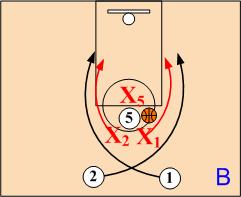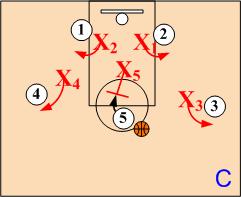- Offensive Techniques & Strategies
Disrupting High Post Split Screens
Automatic Switch
High Post Splits were a staple in the late 1950's and 1960's. Because of its simplicity, the high post split offense is a good one to teach in youth and the lower levels of basketball. Since the high post split is a quick hitting offense, it can be devastating to any team not prepared to defended them.

Defender X5 should deny all passes to high post. However, when high post receives the ball with back to basket, X5 steps off (arms length) and plays the passing lane. Defenders X1 and X2 drop to level of ball.

When O1 and O2 execute high post split, X1 and X2 switch, bumping and forcing cutters O1 and O2 wide.

When high post O5 turns and faces up, X5 immediately steps up and "Jams" O5, forcing O5 to corner pushpoint. Defenders X1, X2, X3, and X4 assume strong pass denial positions.

Disrupting Low Post Splits
Low post splits have been an integral part of basketball since its origins. Low post splits create moving screens that can free up a cutter for a hand-off and easy layup or open short jump shot. Dropping back and switching on the split is an effective way to defend it.

Defender X5 should deny all passes to the low post. However, when the low post receives the ball with back to basket, X5 steps off (arms length) and plays the passing lane. Defenders X1 and X2 drop to level of ball.

When O1 and O2 execute low post split, defenders X1 and X2 switch, bumping and forcing cutters O1 and O2 wide.
© 2026 HoopTactics All Rights Reserved.
